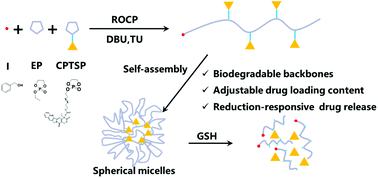当前位置:
X-MOL 学术
›
Biomater. Sci.
›
论文详情
Our official English website, www.x-mol.net, welcomes your
feedback! (Note: you will need to create a separate account there.)
Reduction-responsive amphiphilic polymeric prodrugs of camptothecin–polyphosphoester for cancer chemotherapy†
Biomaterials Science ( IF 5.8 ) Pub Date : 2018-03-13 00:00:00 , DOI: 10.1039/c8bm00162f Hua Jin 1, 2, 3, 4, 5 , Mo Sun 1, 2, 3, 4, 5 , Leilei Shi 1, 2, 3, 4, 5 , Xinyuan Zhu 1, 2, 3, 4, 5 , Wei Huang 1, 2, 3, 4, 5 , Deyue Yan 1, 2, 3, 4, 5
Biomaterials Science ( IF 5.8 ) Pub Date : 2018-03-13 00:00:00 , DOI: 10.1039/c8bm00162f Hua Jin 1, 2, 3, 4, 5 , Mo Sun 1, 2, 3, 4, 5 , Leilei Shi 1, 2, 3, 4, 5 , Xinyuan Zhu 1, 2, 3, 4, 5 , Wei Huang 1, 2, 3, 4, 5 , Deyue Yan 1, 2, 3, 4, 5
Affiliation

|
As one of the promising prodrug strategies, amphiphilic polymeric prodrugs can be constructed by conjugating some small molecular hydrophobic anticancer drugs onto a hydrophilic biodegradable and biocompatible polymer, which further self-assembles into nanoparticles with controllable drug loading. Here, a biocompatible and biodegradable polyphosphoester and a broad-spectrum anticancer drug camptothecin (CPT) were selected as model compounds. We first designed and synthesized a novel cyclic phosphoester monomer (CPTSP) containing a disulfide bond linker and CPT as a side group. Then a reduction-responsive amphiphilic polymeric prodrug (PCPTSP-co-PEEP) was prepared through the ring-opening copolymerization of CPTSP and a common cyclic phosphoester monomer containing ethyl (EEP) as the side group, which was initiated by benzyl alcohol with 1,8-diazabicycloundec-7-ene (DBU) and thiourea (TU) as catalysts. The resulting PCPTSP-co-PEEPs could self-assemble into micelles in water due to their hydrophilic polyphosphoester main chain and some hydrophobic CPT side groups. The average size and the drug loading content of these micelles can be controlled by adjusting the feed molar ratio of EEP and CPTSP. The average hydrodynamic diameter increased from 190 nm to 250 nm when the molar ratio of EEP/CPTSP was adjusted from 9/1 to 49/1. These micelles possessed appropriate stability under physiological conditions and degraded in the reduction medium according to their change in size monitored by DLS measurement. Their reduction-responsive properties were also confirmed by the in vitro drug release behavior. Moreover, these micelles could enter into HT29 tumor cells via endocytosis and released CPT efficiently to inhibit their proliferation. The in vivo tumor inhibition rate of these polymeric prodrugs was 73.4%, which was about two fold that for free CPT (36.5%). This approach of polymeric prodrugs based on polyphosphoesters can be extended to other anticancer drugs to construct smart drug delivery systems for cancer treatment.
中文翻译:

喜树碱-多磷酸酯的还原反应性两亲聚合物前药用于癌症化疗†
作为一种有前途的前药策略,两亲性聚合物前药可以通过将一些小分子疏水性抗癌药物缀合到亲水性可生物降解且生物相容的聚合物上来构建,该聚合物可进一步自组装成具有可控药物载量的纳米颗粒。在这里,选择一种生物相容性和可生物降解的聚磷酸酯和一种广谱抗癌药物喜树碱(CPT)作为模型化合物。我们首先设计并合成了一种新型的环状磷酸酯单体(CPTSP),其中含有二硫键连接子和CPT作为侧基。然后是对还原反应敏感的两亲聚合物前药(PCPTSP- co-PEEP)是通过CPTSP和含有乙基(EEP)作为侧基的普通环状磷酸酯单体的开环共聚反应制备的,该单体是由苯甲醇与1,8-二氮杂双环十一碳7-烯(DBU)和硫脲引发的(TU)作为催化剂。所得的PCPTSP- co-PEEP由于其亲水的聚磷酸酯主链和一些疏水的CPT侧基,可以在水中自组装成胶束。这些胶束的平均大小和载药量可以通过调节EEP和CPTSP的进料摩尔比来控制。当EEP / CPTSP的摩尔比从9/1调整为49/1时,平均流体动力学直径从190 nm增加到250 nm。这些胶束在生理条件下具有适当的稳定性,并且根据其通过DLS测量监测的尺寸变化在还原培养基中降解。通过体外药物释放行为也证实了它们的还原反应特性。而且,这些胶束可以通过以下途径进入HT29肿瘤细胞内吞并有效释放CPT以抑制其增殖。在体内,这些聚合物前体药物的肿瘤抑制率为73.4%,这是大约两倍,对于游离CPT(36.5%)。这种基于聚磷酸酯的聚合前药的方法可以扩展到其他抗癌药物,以构建用于癌症治疗的智能药物递送系统。
更新日期:2018-03-13
中文翻译:

喜树碱-多磷酸酯的还原反应性两亲聚合物前药用于癌症化疗†
作为一种有前途的前药策略,两亲性聚合物前药可以通过将一些小分子疏水性抗癌药物缀合到亲水性可生物降解且生物相容的聚合物上来构建,该聚合物可进一步自组装成具有可控药物载量的纳米颗粒。在这里,选择一种生物相容性和可生物降解的聚磷酸酯和一种广谱抗癌药物喜树碱(CPT)作为模型化合物。我们首先设计并合成了一种新型的环状磷酸酯单体(CPTSP),其中含有二硫键连接子和CPT作为侧基。然后是对还原反应敏感的两亲聚合物前药(PCPTSP- co-PEEP)是通过CPTSP和含有乙基(EEP)作为侧基的普通环状磷酸酯单体的开环共聚反应制备的,该单体是由苯甲醇与1,8-二氮杂双环十一碳7-烯(DBU)和硫脲引发的(TU)作为催化剂。所得的PCPTSP- co-PEEP由于其亲水的聚磷酸酯主链和一些疏水的CPT侧基,可以在水中自组装成胶束。这些胶束的平均大小和载药量可以通过调节EEP和CPTSP的进料摩尔比来控制。当EEP / CPTSP的摩尔比从9/1调整为49/1时,平均流体动力学直径从190 nm增加到250 nm。这些胶束在生理条件下具有适当的稳定性,并且根据其通过DLS测量监测的尺寸变化在还原培养基中降解。通过体外药物释放行为也证实了它们的还原反应特性。而且,这些胶束可以通过以下途径进入HT29肿瘤细胞内吞并有效释放CPT以抑制其增殖。在体内,这些聚合物前体药物的肿瘤抑制率为73.4%,这是大约两倍,对于游离CPT(36.5%)。这种基于聚磷酸酯的聚合前药的方法可以扩展到其他抗癌药物,以构建用于癌症治疗的智能药物递送系统。











































 京公网安备 11010802027423号
京公网安备 11010802027423号